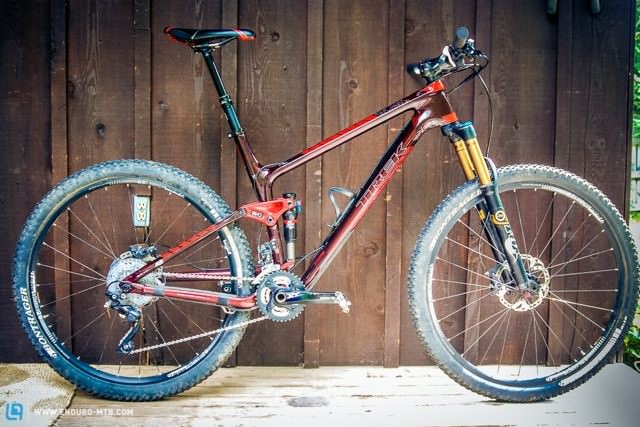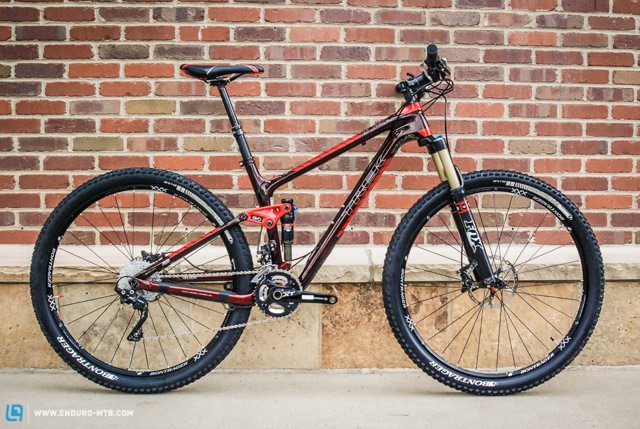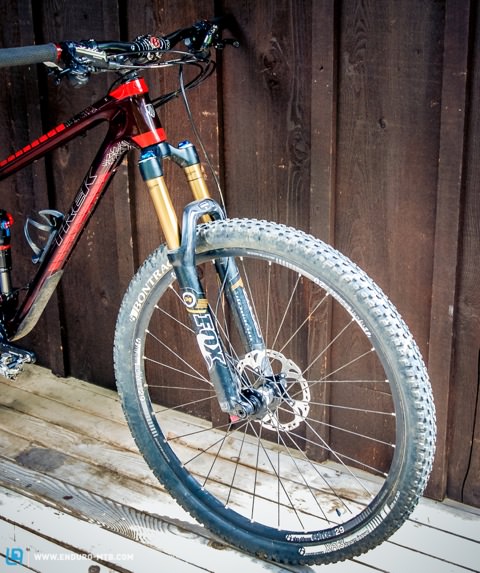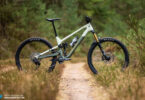Bike Tuning: Trek Fuel EX 9.8 29er Gets Pimped

“Pimp My Ride,” courtesy of Enduro Mag Customs: turning a copy-editor’s mild-mannered trailbike into an enduro-oriented weapon.
I first rode a friend’s Trek Fuel EX 9.8 29er last year, and I was really impressed. Although it weighed a few pounds more than my Giant Trance Advanced 0, I immediately felt comfortable on the Trek. Part of this may be due to my 6’3” (190 cm) height, on an XL frame the “wagon wheels” can look and feel quite proportional. The Fuel also motored up the climbs, and I have to do a lot of climbing here in the mountains of Steamboat, Colorado. Although I also thought about getting a Remedy 650b (and have always been willing to add a little weight for better descending), I thought the Fuel would probably better fit the trails I ride 95% of the time, and I wanted to try a 29er for at least a season after many years on 26” trail and DH bikes.

After acquiring my very own Fuel over the winter, I happened to chance upon a Fox Float 34 with sexy Kashima coating and 140mm of travel. As an added bonus, the large stanchions and muscular lowers certainly looked a lot better with the carbon frame’s big, bad tubes. I was ready to dump the skinny stock Fox 32! The stock stem also ended up in the parts box, replaced with my favorite 70mm. As far as the 34 went, it was love at first sight…and love on the first ride! The DRCV rear end has always felt a little plusher than its numbers reveal, and now the front stacked right up. Steamboat was still snowy in March, but the deserts of Utah beckoned.
After a quick shakedown on the Moab Brand trails, I booked a shuttle for snowline: UPS had just opened, and LPS plus Porcupine Rim were dry below. As you might imagine, the big wheels steamrollered the chunky ledges and rocks of Utah, I was a happy camper! The wheelbase of my Fuel also grew a little from 47” (1194mm) to 47.5” (1207mm). The only unhappy part of my bike was the rear wheel, which didn’t appreciate some of the drops and sideways landings that the prickly rocks of Porcupine dished out.

Weeks later, the snow finally retreated from the Rocky Mountains and some of my favorite home trails began to open. I decided to use some Bontrager rim strips and valves, along with Continental sealant to set the Bontrager XR3 tires up tubeless. I could now run lower pressures without pinch-flatting. I liked my Fuel, but quicker turns revealed that my fork upgrade had also raised my BB height. The stock height with the 2.3” tires was about 13.6” (345mm), but the longer-travel fork had raised it to 13.9” (353mm), which is definitely on the high side for my taste.
Suddenly, a bike-nerd light bulb illuminated the wilderness of my gray matter: I remembered reading about pro riders using offset bushings to lower and slacken their production DH frames. With the help of Google, I found www.offsetbushings.com, which promised to address my issue without need of an Angleset. Due to my shock’s DRCV design, I could only install an offset bushing on the lower bushing, but it turns out that was all I needed. For £15 (roughly $30 with shipping), I received a custom brass bushing which I installed. My BB returned to its stock height, while the slacker front end pushed my wheelbase out to a DH-worthy 47.75” (1213mm) on my XL frame.

How does it ride? With wheels on the ground, the wheelbase and grip remind me of an older DH bike (I’ve owned two generations of Giant Glory’s), albeit one that is a little flexier due to the lighter wheels and frame. Once the seat is dropped, I can keep leaning the bike over as far as I want; the bike wants to be aggressively carved through corners rather than steered. The stability is impressive, there’s a lot of wheel out in front of you and trail chunder disappears beneath those big tires. The lower BB has put me back “in” the bike rather than riding “on” it. Although I need an angle finder or Photoshop wizard to verify, I’d guess the head angle is 68.5° or slacker.

Larger drops still reveal the Fuel’s short-travel trailbike roots, and the stock wheels are certainly weaker than my last set of DT Spline 26ers, but overall the bike descends faster and feels more sure-footed than any other trailbike I’ve owned. I haven’t pulled out the stopwatch yet, but my butt-speedometer tells me I am carrying more speed out of corners and in most places on my favorite trails. Climbing? About the same, with a touch more floppiness on the front wheel (a worthwhile trade-off). Overall, I’d say my ride is definitely pimped—metaphorically speaking, I’d have to bitch-slap anyone who tried to pry the Fuel out of my cold, dead, full-finger-gloved fingers!

P.S. I now see that Trek is releasing a carbon Remedy 29er with a new “Boost 148” wheel system to address the lateral stiffness issues of 29er wheels. Did they read my mind? Looks like I might have to consider “lovin’ and leaving” my current beauty when 2015 rolls around!
Words & Pictures: John Morse
Did you enjoy this article? If so, we would be stoked if you decide to support us with a monthly contribution. By becoming a supporter of ENDURO, you will help secure a sustainable future for high-quality mountain bike journalism. Click here to learn more.







